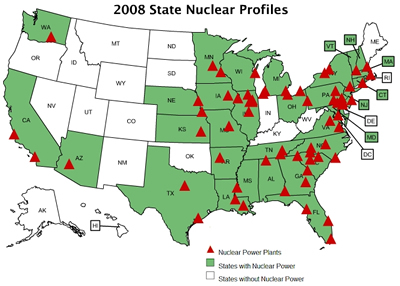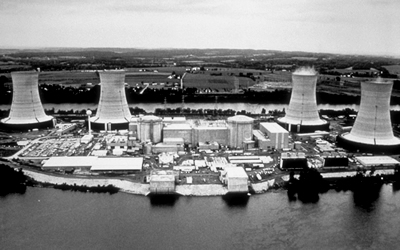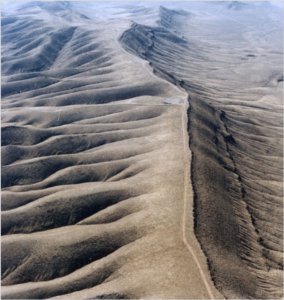- The Vitruvian Plant: Powering the Future #10-2284
-
Background
History of Nuclear Energy Nuclear Agencies and Regulations Nuclear Power in the Public Eye Economics of Nuclear Energy Radioactivity Basics Nuclear Reactor Basics Current Reactor Designs Processing Radioactive Materials Remote Handling Uses of Radiation Archimedes Filter Technology New Generation Reactors
- Components
- Project
Nuclear Power in the Public Eye
Overview
When the public thinks about nuclear power plants, two names come immediately to
mind: Three Mile Island and Chernobyl. The failures at those two power plants will
forever overshadow the
hundreds of other successful nuclear facilities. In 2009, nuclear energy
provided
20% of the nation's electrical power needs.
Since the 1950's, the world has seen nuclear energy develop into one of the top three sources of generating electrical power. In the current climate of oil's limited availability and high prices, as well as coal power plants' pollution, nuclear power is undergoing a makeover. People are starting to see it as a source of "green energy".
The world's first nuclear power plant was the APS-1, a 5-megawatt reactor, in Obninsk, USSR. Operations began in December 1954, and closed 48 years later. The first civilian-operated nuclear power plant in the United States was in Shippingport, Pennsylvania. On December 18, 1957, it contributed its first power to the Pittsburgh area. It was decommissioned after 25 years in 1982.
Since the 1950's, the world has seen nuclear energy develop into one of the top three sources of generating electrical power. In the current climate of oil's limited availability and high prices, as well as coal power plants' pollution, nuclear power is undergoing a makeover. People are starting to see it as a source of "green energy".
The world's first nuclear power plant was the APS-1, a 5-megawatt reactor, in Obninsk, USSR. Operations began in December 1954, and closed 48 years later. The first civilian-operated nuclear power plant in the United States was in Shippingport, Pennsylvania. On December 18, 1957, it contributed its first power to the Pittsburgh area. It was decommissioned after 25 years in 1982.
 Image courtesy of The Oak Ridge Associated Universities |
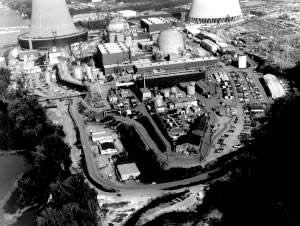 Image courtesy of The Federation of American Scientists |
Three Mile Island
On March 28, 1979, the Three Mile Island nuclear power plant near Harrisburg, Pennsylvania
experienced the worst malfunction in the history of US nuclear power operations.
Although the accident did not kill or severely injure plant workers or civilians,
it did promote many reforms to improve the safety of modern-day power plants. Some
of these reforms included the need for improved emergency response, further training
of reactor operators, improved human factors engineering, and protection against
radiation exposure.
The disaster began at approximately four oí clock in the morning, when the plant experienced a failure in the secondary non-nuclear section of the plant. Then, either an electrical or mechanical failure within the main feedwater pumps eventually prevented the steam generators from removing heat. First, the turbine and then the reactor shut down completely. Instantaneously, the pressure within the primary sector of the plant (the actual nuclear portion) began to accumulate. In order to relieve some of the pressure from overwhelming the system, the pilot-operated relief valve opened. The valve should have closed itself once the pressure decreased back to its metabolic level, but it failed to shut, and signals that should have warned that the valve remained open did not go off. As a result, cooling water flooded from the still-opened valve and caused the very core, the epicenter of the entire reactor to overheat.
Because an adequate amount of coolant was not available, the nuclear fuel overheated to the stage at which the zirconium cladding (the very long, metal tubes which hold the nuclear fuel) ruptured and the pellets of fuel (uranium-235 and plutonium-238) began to melt. It was later found that an estimated 50% of the core disintegrated by the end of the very first stage of the accident.
The very next day the core of the plant appeared to be properly cooled and working efficiently, and reports from the plant stated that the system had stabilized. However, the governor of Pennsylvania and the Nuclear Regulatory Commission (NRC) had to mandate the evacuation of all plant workers and civilians within a 5-mile radius on the morning of March 30th when a significant amount of radiation leaked into the air.
Within a short amount of time a large hydrogen bubble appeared in the dome of the pressure vessel, the part of the system that contains the reactor core. Fears of the bubble rupturing and consequently damaging the pressure vessel were quenched on Sunday, April 1st, when experts concluded that the imposing bubble could not possibly burn or explode because the pressure valve was deprived of oxygen. Fears somewhat subsided when the bubble eventually decreased in size.
Although the core meltdown was a very severe, if not the most severe malfunction that can occur at a nuclear power facility, it did not produce the more dramatic and harrowing consequences that scientists and experts had feared. However, it did spark a growing concern over having such massive systems generating power in "our own backyards." What if it were to happen again? Not only did this disaster cause a greater awareness of the dangers of nuclear power, but it also gave rise to new technological advances. Unfortunately, the systemís composition still remains essentially the same today as it did in March of 1979.
The disaster began at approximately four oí clock in the morning, when the plant experienced a failure in the secondary non-nuclear section of the plant. Then, either an electrical or mechanical failure within the main feedwater pumps eventually prevented the steam generators from removing heat. First, the turbine and then the reactor shut down completely. Instantaneously, the pressure within the primary sector of the plant (the actual nuclear portion) began to accumulate. In order to relieve some of the pressure from overwhelming the system, the pilot-operated relief valve opened. The valve should have closed itself once the pressure decreased back to its metabolic level, but it failed to shut, and signals that should have warned that the valve remained open did not go off. As a result, cooling water flooded from the still-opened valve and caused the very core, the epicenter of the entire reactor to overheat.
Because an adequate amount of coolant was not available, the nuclear fuel overheated to the stage at which the zirconium cladding (the very long, metal tubes which hold the nuclear fuel) ruptured and the pellets of fuel (uranium-235 and plutonium-238) began to melt. It was later found that an estimated 50% of the core disintegrated by the end of the very first stage of the accident.
The very next day the core of the plant appeared to be properly cooled and working efficiently, and reports from the plant stated that the system had stabilized. However, the governor of Pennsylvania and the Nuclear Regulatory Commission (NRC) had to mandate the evacuation of all plant workers and civilians within a 5-mile radius on the morning of March 30th when a significant amount of radiation leaked into the air.
Within a short amount of time a large hydrogen bubble appeared in the dome of the pressure vessel, the part of the system that contains the reactor core. Fears of the bubble rupturing and consequently damaging the pressure vessel were quenched on Sunday, April 1st, when experts concluded that the imposing bubble could not possibly burn or explode because the pressure valve was deprived of oxygen. Fears somewhat subsided when the bubble eventually decreased in size.
Although the core meltdown was a very severe, if not the most severe malfunction that can occur at a nuclear power facility, it did not produce the more dramatic and harrowing consequences that scientists and experts had feared. However, it did spark a growing concern over having such massive systems generating power in "our own backyards." What if it were to happen again? Not only did this disaster cause a greater awareness of the dangers of nuclear power, but it also gave rise to new technological advances. Unfortunately, the systemís composition still remains essentially the same today as it did in March of 1979.
Chernobyl
Seven years later, on April 26th, 1986, the Chernobyl nuclear reactor was undergoing a test. Originally
scheduled for April 25th, the test was delayed until night time so that power to
the capital, Kiev, could be maintained throughout the day. The test was designed
to see if the reactor turbines could keep the reactor cool in the event of a power
outage until the generators came on line. Technicians reduced the reactor to 25%
power. However, for unknown reasons, the power dropped to under 1%. Consequently,
they had to slowly and incrementally build up the power. Suddenly, the output spiked
and began to increase uncontrollably. For the purpose of the test, the safety and
emergency systems had been turned off to prevent the test being interrupted. The
final emergency shut-off should have stopped the out of control chain reaction,
but it failed. In a fraction of a second, the power level and temperature of reactor
No. 4 rose exponentially. An explosion rocked the facility. The one million kilogram
reactor cap was blown off, the fuel rods melted at 2000 degrees Celsius, and the
graphite covering the reactor ignited. During the inferno, the fission products
were absorbed into the atmosphere and released 100 times more radiation than the
the atomic bomb dropped on Hiroshima.
The light-water cooled graphite-moderated reactors (GMR) used by the Chernobyl power plant have been criticized for years by Western nuclear experts for the temperamental nature of their control rods. A GMR has no containment structure and requires a lot of combustible graphite in the core to work. During the disaster, the engineers initially pushed the control rods into the reactor to reduce the reactor's power level to 25%. When the power plunged to 1%, they had to remove the rods to increase the power. When the emergency shut-off failed to function, they had to push the rods completely into the reactor. Inexplicably, the reactor gained power.
As shown in the following two maps, the airborne radiation was carried over Scandanavia, Europe, and Asia. In 2002, 84% of the three million people in the Ukraine who had been exposed to radiation were registered as sick, including one million children. The Chernobyl Forum Report of 2005 stated that there would be roughly 4000 deaths due to the disaster. In addition, over 1800 children and adolescents have contracted thyroid cancer due to direct exposure to the Chernobyl radiation.
As a result of the disaster, the Chernobyl plant was shut down, as was all of Belarusí nuclear power plants. In other countries, including those in the West, tighter restrictions were placed on nuclear power. This accident only heightened Americaís distrust of nuclear power plants, and further prevented new plants from being built around the United States.
The light-water cooled graphite-moderated reactors (GMR) used by the Chernobyl power plant have been criticized for years by Western nuclear experts for the temperamental nature of their control rods. A GMR has no containment structure and requires a lot of combustible graphite in the core to work. During the disaster, the engineers initially pushed the control rods into the reactor to reduce the reactor's power level to 25%. When the power plunged to 1%, they had to remove the rods to increase the power. When the emergency shut-off failed to function, they had to push the rods completely into the reactor. Inexplicably, the reactor gained power.
As shown in the following two maps, the airborne radiation was carried over Scandanavia, Europe, and Asia. In 2002, 84% of the three million people in the Ukraine who had been exposed to radiation were registered as sick, including one million children. The Chernobyl Forum Report of 2005 stated that there would be roughly 4000 deaths due to the disaster. In addition, over 1800 children and adolescents have contracted thyroid cancer due to direct exposure to the Chernobyl radiation.
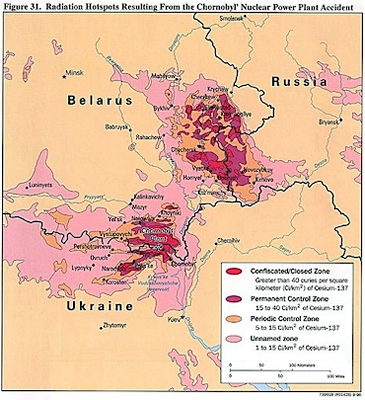
|
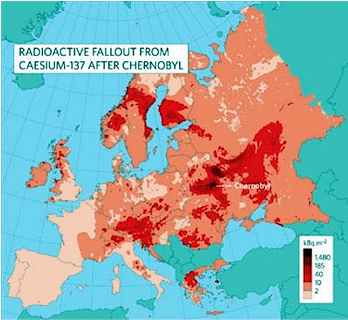 |
| Image courtesy of ZONU - World Mays and Satellite Photos | Image courtesy of Atom Watch |
As a result of the disaster, the Chernobyl plant was shut down, as was all of Belarusí nuclear power plants. In other countries, including those in the West, tighter restrictions were placed on nuclear power. This accident only heightened Americaís distrust of nuclear power plants, and further prevented new plants from being built around the United States.
Yucca Mountain
Yucca Mountain came about when the Nuclear Waste Policy
Act of 1982 made deep storage the preferred form of disposal for nuclear waste.
Later in 1987 Congress passed an amendment to the act, forcing the Department of
energy (DOE) to focus only on Yucca Mountain, allowing no alternative disposal options.
Yucca Mountain was picked as the site of our countryís repository for several reasons. First, it is located on federal-owned land around 100 miles north of Las Vegas, Nevada in the middle of the desert. Second the area has an extremely dry climate, getting about 7.5 in. of rain per year. Also about 95% of the rain either runs off, evaporates, or is used by desert vegetation. Furthermore, Yucca Mountain has a very deep water table, and the repository is located approximately 1000 ft. below the surface and 1000 ft. above the water table. This dry climate is pertinent because water is the primary way radioactive material can escape from a repository.
There are many who are against Yucca Mountain and claim that it was picked for political, not scientific, reasons. They emphasize that better alternatives are available, but that they havenít been looked at because of the amendment in 1987 by Congress. In 2003, the state of Nevada stated that Yucca Mountain was the only repository in the world that was located above the water table. It is also the only one located in an area with high seismic and volcanic activity, which pose large risks to the safe storage of the radioactive material.
The DOE has heard these claims and in March, 2010 it withdrew its application for Yucca Mountain. The Nuclear Regulatory commission (NRC), however, believes that the DOE does not have the authority to withdraw its application. In early 2011 the US Court of Appeals in Washington D.C. will hold hearings to address the issue.
Yucca Mountain was picked as the site of our countryís repository for several reasons. First, it is located on federal-owned land around 100 miles north of Las Vegas, Nevada in the middle of the desert. Second the area has an extremely dry climate, getting about 7.5 in. of rain per year. Also about 95% of the rain either runs off, evaporates, or is used by desert vegetation. Furthermore, Yucca Mountain has a very deep water table, and the repository is located approximately 1000 ft. below the surface and 1000 ft. above the water table. This dry climate is pertinent because water is the primary way radioactive material can escape from a repository.
There are many who are against Yucca Mountain and claim that it was picked for political, not scientific, reasons. They emphasize that better alternatives are available, but that they havenít been looked at because of the amendment in 1987 by Congress. In 2003, the state of Nevada stated that Yucca Mountain was the only repository in the world that was located above the water table. It is also the only one located in an area with high seismic and volcanic activity, which pose large risks to the safe storage of the radioactive material.
The DOE has heard these claims and in March, 2010 it withdrew its application for Yucca Mountain. The Nuclear Regulatory commission (NRC), however, believes that the DOE does not have the authority to withdraw its application. In early 2011 the US Court of Appeals in Washington D.C. will hold hearings to address the issue.
1971 - 1984: Years of Challenge
http://reepedia.com/education/smart-grid-education/2155-19711984-years-of-challenge-smart-grid.html
American Wasteland
http://www.nytimes.com/2010/02/28/books/review/Bock-t.html?_r=1&ref=yuccamountain
Backgrounder on the Three Mile Island Accident
http://www.nrc.gov/reading-rm/doc-collections/fact-sheets/3mile-isle.html
Chernobyl Nuclear Power plant accident 1996
http://www.zonu.com/fullsize-en/2009-09-18-7185/Chernobyl-Nuclear-Power-plant-accident-1996.html
Electric Power Industry 2009: Year in Review
http://www.eia.doe.gov/cneaf/electricity/epa/epa_sum.html
Introduction to Nuclear
http://www.eia.doe.gov/cneaf/nuclear/page/nuc_reactors/reactsum.html
Lessons for reactor safety and disaster management
http://chernobyl.info/index.php?userhash=884573&navID=51&lID=2
Model of Fuel Elements for the Obninsk APS-1 Reactor
http://www.orau.org/ptp/collection/reactors/obninsk.htm
Nuclear Power in the USA
http://www.world-nuclear.org/info/inf41.html
Nuclear power is true 'green' energy
http://www.washingtontimes.com/news/2009/jan/29/nuclear-power-is-true-green-energy/
Obninsk Reactor - 40 Year Anniversary (1994)
http://www.orau.org/ptp/collection/medalsmementoes/obninsk40years.htm
Overview of health consequences
http://chernobyl.info/index.php?userhash=884573&navID=21&lID=2
Overview: Yucca Mountain Project
http://nuclearfiles.org/menu/key-issues/nuclear-energy/issues/yucca-mountain/yucca-mountain-overview.html
Shippingport Nuclear Power Station (1958)
http://www.asme.org/Communities/History/Landmarks/Shippingport_Nuclear_Power.cfm
Shippingport nuclear powerplant
http://www.fas.org/irp/imint/doe_shippingport_01.htm
Technical data on the reactor
http://chernobyl.info/index.php?userhash=884573&navID=9&lID=2
The explosion of the reactor
http://chernobyl.info/index.php?userhash=884573&navID=10&lID=2
Three Mile Island Emergancy: Timeline
http://www.threemileisland.org/virtual_museum/index.html
Three Mile Island: The Inside Story
http://americanhistory.si.edu/tmi/
Yucca Mountain
http://www.nuclearfiles.org/menu/key-issues/nuclear-energy/issues/yucca-mountain/index.htm
